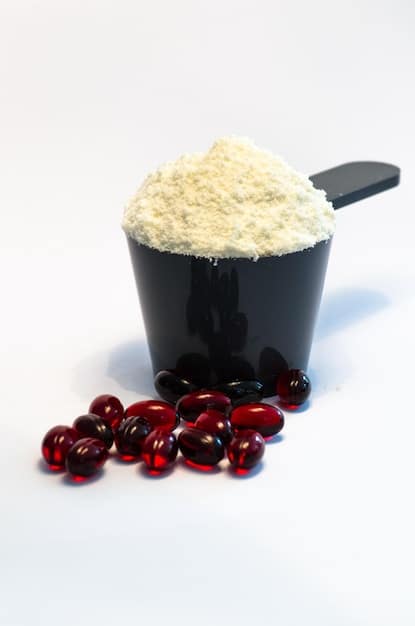Protein Powder Showdown: Whey, Casein, Plant-Based – Best for Your Goals?

Navigating the array of protein powders—whey, casein, and plant-based—requires understanding their unique absorption rates, amino acid profiles, and nutritional benefits to align with individual fitness, dietary, or health objectives, optimizing muscle growth, recovery, or weight management.
In the vast landscape of nutritional supplements, the choice of protein powder can often feel overwhelming. From the classic Protein Powder Showdown: Whey vs. Casein vs. Plant-Based – Which is Best for Your Goals? to newer botanical blends, understanding their unique properties is key to optimizing your fitness journey. This guide delves into the distinct characteristics of each type, helping you make an informed decision tailored to your specific needs.
decoding protein sources: a foundational understanding
Protein is an indispensable macronutrient, vital for an array of bodily functions, not least of which is muscle repair and growth. While whole food sources of protein are paramount, protein powders offer a convenient and efficient way to supplement dietary intake. Each type, however, delivers a unique profile in terms of digestion speed, amino acid availability, and overall biological value.
The science of protein hinges significantly on its amino acid composition. Amino acids are the building blocks of protein, and among them, nine are classified as essential, meaning the body cannot synthesize them and they must be obtained through diet. A “complete protein” source provides all nine essential amino acids in sufficient quantities. This distinction is particularly relevant when comparing animal-derived and plant-based protein powders, as their natural amino acid profiles can differ markedly.
Furthermore, the bioavailability of a protein source—how effectively the body can absorb and utilize its amino acids—is a critical factor. Various methods, such as the Protein Digestibility Corrected Amino Acid Score (PDCAAS) and the Digestible Indispensable Amino Acid Score (DIAAS), are used by scientists to evaluate protein quality, providing a measurable basis for comparison beyond mere protein content per serving.
The Role of Amino Acids in Protein Efficiency
Amino acids are not merely generic building blocks; specific essential amino acids play magnified roles in muscle protein synthesis (MPS) and other critical processes. Leucine, one of the branched-chain amino acids (BCAAs), is a potent activator of the mTOR pathway, a key regulator of cell growth and metabolism, specifically signaling for muscle growth. Understanding this hierarchy helps explain why some protein sources are more lauded for their anabolic potential than others.
- Leucine: Triggers muscle protein synthesis.
- Isoleucine & Valine: Support energy production and recovery.
- Complete Profile: Ensures all necessary building blocks for repair.
- Bioavailability: Dictates how efficiently the body uses the protein.
Beyond muscle repair, protein also supports satiety, aids in weight management by increasing thermogenesis, and plays a role in enzyme and hormone production. The choice of protein powder, therefore, isn’t just about athletic performance; it’s about holistic health optimization. This initial exploration sets the stage for a deeper dive into the specific characteristics of whey, casein, and plant-based proteins, allowing for an informed comparison based on individual goals and lifestyle factors.
Ultimately, selecting a protein powder involves more than just picking a flavor. It’s about aligning the supplement’s intrinsic properties with your desired outcomes, whether that’s rapid post-workout recovery, sustained satiety, or adherence to specific dietary principles. Understanding the fundamental science behind protein and amino acids provides the necessary lens through which to evaluate each contender in this protein powder showdown.
whey protein: the rapid absorption champion
Whey protein stands as a cornerstone in the supplement regimens of athletes and fitness enthusiasts worldwide, largely due to its unparalleled rapid absorption rate and rich amino acid profile. Derived from milk during the cheese-making process, whey is celebrated for its efficiency in stimulating muscle protein synthesis, making it an ideal choice for post-workout recovery and muscle growth.
Its high biological value (BV) signifies that a significant portion of its absorbed protein is utilized by the body. Whey is particularly abundant in branched-chain amino acids (BCAAs), especially leucine, which is a pivotal signal for initiating muscle repair and growth processes. This rapid delivery of essential amino acids into the bloodstream creates an “anabolic window,” maximizing the body’s ability to recover and build muscle immediately after intense physical activity.
Varieties and Their Nuances
Whey protein is typically available in several forms, each offering distinct benefits and nutritional compositions based on their processing methods:
- Whey Protein Concentrate (WPC): This is the least processed type, containing varying levels of protein (usually 70-80%), along with some lactose, fat, and carbohydrates. It’s generally more affordable and retains more beneficial components like immunoglobulins, which can support immune health.
- Whey Protein Isolate (WPI): Undergoes further processing to remove most of the lactose and fat, resulting in a product with a higher protein content (90%+). WPI is often preferred by individuals who are lactose intolerant or those looking for a leaner protein source with minimal carbohydrates and fats.
- Whey Protein Hydrolysate (WPH): This form is pre-digested, meaning the protein has been partially broken down into smaller peptides. This makes WPH the fastest absorbing among whey types, often used in infant formulas and medical protein supplements. Its taste can be more bitter due to the hydrolysis process.
The choice among these varieties often comes down to individual dietary needs, digestive sensitivities, and budget. While WPC offers a more wholesome profile with beneficial compounds, WPI and WPH provide faster absorption and are suitable for those with specific dietary restrictions.
Optimal Timing and Applications
The rapid digestion of whey protein makes it uniquely suited for certain applications. Its most common use is immediately following a workout, where it can swiftly deliver amino acids to depleted and damaged muscle tissues, facilitating recovery and growth. This “post-workout window” is crucial for maximizing the anabolic response.
However, whey’s utility isn’t limited to post-exercise. It can also be incorporated into breakfast to kickstart muscle protein synthesis for the day, or as a convenient snack to boost daily protein intake, especially for those with high protein requirements. For individuals aiming for weight loss, whey protein can contribute to satiety and help preserve lean muscle mass during caloric restriction.

Despite its numerous benefits, some individuals may experience minor digestive issues such as bloating or gas, particularly from WPC due to its lactose content. For those with dairy allergies, whey protein is not an option. In such cases, other protein sources, particularly plant-based alternatives, become viable considerations. Whey protein remains a highly effective and popular choice for those prioritizing rapid muscle recovery and growth, offering versatility across different forms to suit various dietary preferences.
casein protein: the slow-release strategist
In stark contrast to whey, casein protein is celebrated for its unique slow-digesting properties, making it an ideal choice for sustained amino acid release. Also derived from milk, but comprising about 80% of milk protein (with whey making up the remaining 20%), casein forms a gel-like substance in the stomach upon consumption. This characteristic slows down its digestion and absorption, providing a gradual and steady trickle of amino acids into the bloodstream over several hours.
This prolonged release directly translates to a prolonged anti-catabolic effect, meaning it helps prevent muscle protein breakdown. While whey quickly spikes muscle protein synthesis, casein helps maintain elevated amino acid levels for an extended period, making it particularly beneficial during times of fasting, such as overnight sleep, or between meals when protein intake might be sparse.
Types and Benefits of Casein
Similar to whey, casein primarily comes in different forms, though the most common are:
- Micellar Casein: This is the purest and most natural form, extracted through a gentle filtration process that isolates the casein micelles from other milk components. It digests slowly, preserving its natural structure and beneficial properties.
- Calcium Caseinate: This form is created when casein is chemically extracted using a calcium salt. While it’s also a slow-digesting protein, its processing can slightly alter its protein structure compared to micellar casein.
The primary benefit of casein lies in its ability to provide a sustained supply of amino acids. This makes it an excellent choice for:
- Nighttime Recovery: Consuming casein before bed can support muscle repair and growth throughout the night, combating the natural catabolic state that occurs during sleep.
- Extended Satiety: Due to its slow digestion, casein can promote a feeling of fullness for longer periods, which can be advantageous for weight management strategies or controlling hunger between meals.
- Muscle Preservation: Its anti-catabolic properties are crucial during periods of caloric deficit or intense training, helping to protect lean muscle mass from breakdown.
While often overshadowed by whey for immediate post-workout benefits, casein’s strategic slow release makes it an invaluable tool for continuous muscle support and recovery. Its robust amino acid profile, including a good supply of BCAAs, further reinforces its role as a high-quality protein source. Many athletes incorporate both whey and casein into their diets, utilizing whey for rapid post-exercise recovery and casein for sustained support during longer periods without food.
However, like whey, casein is dairy-derived, meaning individuals with lactose intolerance or dairy allergies will need to consider plant-based alternatives. Despite this, for those who can tolerate dairy, casein offers a distinct advantage, providing a complementary approach to protein supplementation that focuses on sustained nourishment and muscle protection. Its role as the “sleep protein” or “marathon protein” is well-earned, highlighting its unique contribution to comprehensive nutritional strategies.
plant-based proteins: the inclusive uprising
The landscape of protein supplementation has dramatically diversified with the rise of plant-based proteins, catering to an expanding demographic of vegans, vegetarians, those with dairy intolerances or allergies, and individuals simply seeking to reduce their animal product consumption. No longer niche, these proteins have evolved from simple soy or rice options to sophisticated blends offering complete amino acid profiles and diverse nutritional benefits.
Unlike animal-derived proteins which are typically complete, individual plant protein sources often lack one or more essential amino acids. However, this challenge is elegantly overcome by blending different plant proteins, creating synergistic combinations that provide a comprehensive spectrum of amino acids. Common plant-based protein sources include pea, brown rice, hemp, soy, and pumpkin seed, each bringing its own unique nutritional advantages.
Common Plant-Based Protein Varieties
- Pea Protein: Derived from yellow split peas, pea protein is highly digestible and rich in BCAAs, making it comparable to whey in its ability to support muscle protein synthesis. It’s naturally gluten-free and allergen-friendly.
- Brown Rice Protein: While lower in lysine, brown rice protein is a good source of other essential amino acids. When combined with pea protein, it forms a complete protein profile, enhancing its overall efficacy.
- Hemp Protein: A minimally processed protein derived from the hemp plant, it stands out for its balanced omega-3 and omega-6 fatty acid content, along with fiber and various minerals. While not a complete protein in isolation, its nutritional density is impressive.
- Soy Protein: One of the few complete plant proteins, soy has been a long-standing option. However, some individuals prefer to avoid it due to concerns about phytoestrogens or common allergies.
- Pumpkin Seed Protein: Offers a unique nutty flavor and is rich in zinc, magnesium, and healthy fats, in addition to being a good protein source.
The primary advantage of plant-based proteins lies in their inclusivity and often, their additional health benefits. They are free from common allergens like dairy and soy (depending on the source), appealing to a wider audience. Furthermore, many plant-based proteins come with the added benefits of fiber, vitamins, and minerals, which are naturally present in their source ingredients, contributing to overall digestive health and nutrient intake.
Environmental and Ethical Considerations
Beyond personal health, the growth of plant-based proteins is also driven by increasing environmental consciousness. The production of plant-based proteins generally has a lower environmental footprint compared to animal-derived proteins, requiring less land, water, and emitting fewer greenhouse gases. This aligns with a broader societal shift towards sustainable and ethically sourced food products.
While some early plant-based proteins faced criticism for their texture or taste, significant advancements in processing and flavor technology have led to products that rival their dairy counterparts in palatability and mixability. The availability of diverse plant-based protein blends means consumers no longer have to compromise on taste or nutritional completeness. The “inclusive uprising” of plant-based proteins signifies a major shift in how we view and utilize protein supplementation, offering effective and sustainable alternatives for a diverse set of dietary needs and ethical stances.

This category continues to innovate, providing compelling options for anyone looking to optimize their protein intake while adhering to specific dietary preferences or global ecological responsibilities.
comparing the contenders: absorption, complete proteins, and specific goals
Understanding the unique profiles of whey, casein, and plant-based proteins allows for a more strategic approach to supplementation. The “best” protein powder isn’t a universal answer; it depends entirely on your specific goals, dietary preferences, and lifestyle. Delving deeper into their comparative characteristics reveals distinct advantages for different scenarios.
Absorption Rates and Timing
The speed at which a protein is digested and absorbed is a critical differentiator:
- Whey Protein: Known as a “fast-acting” protein. Its rapid absorption makes it ideal for post-workout recovery, quickly delivering amino acids to muscles to initiate repair and growth. The swift entry of amino acids creates an anabolic surge, vital for immediate muscle replenishment.
- Casein Protein: The “slow-release” protein. Its ability to form a gel in the stomach leads to a gradual, sustained release of amino acids over several hours. This makes it perfect for nighttime consumption, providing anti-catabolic support during extended fasting periods, or for increasing satiety throughout the day.
- Plant-Based Proteins: Absorption rates vary widely depending on the primary source and blend. For example, pea protein is generally well-digested, while brown rice protein might be slightly slower. Blends are designed to offer a complete amino acid profile, but the overall absorption speed is typically moderate—slower than whey but generally faster than micellar casein.
Amino Acid Profile and Completeness
All three types can provide essential amino acids, but their completeness and the concentration of specific muscle-building amino acids, particularly leucine, differ:
- Whey Protein: A complete protein with an excellent amino acid profile, particularly high in BCAAs (leucine, isoleucine, valine). This high BCAA content is why it’s so effective at triggering muscle protein synthesis.
- Casein Protein: Also a complete protein, providing all essential amino acids. While its BCAA content is good, it’s slightly lower than whey, and its benefit lies more in sustained delivery than rapid anabolic signaling.
- Plant-Based Proteins: Individual plant proteins like rice or hemp may be deficient in one or more essential amino acids. However, modern plant-based protein powders are typically blends (e.g., pea and rice protein) specifically formulated to create a complete amino acid profile, ensuring they provide all nine essential amino acids necessary for muscle repair and growth. This “complementary protein” strategy is crucial for vegan and vegetarian athletes.
Specific Goal Alignment
Your ultimate goal should guide your choice:
- Muscle Building & Recovery (immediate post-workout): Whey is often the superior choice due to its rapid absorption and high BCAA content, fostering peak muscle protein synthesis.
- Muscle Preservation & Nighttime Recovery: Casein excels here, providing a steady stream of amino acids to prevent muscle breakdown during sleep or prolonged fasting.
- Weight Management: Both whey and casein can aid satiety. Casein’s slower digestion may help with prolonged fullness. Plant-based proteins with added fiber can also contribute to satiety.
- Dietary Restrictions/Preferences: Plant-based proteins are essential for vegans, vegetarians, and those with dairy allergies or lactose intolerance. They also offer a more sustainable and ethical option.
- General Health & Convenient Protein Boost: Any of the three can serve this purpose, depending on personal preference, taste, and digestive comfort.
For many, a combination approach might be optimal: whey post-workout, casein before bed, and perhaps a plant-based option for general daily protein intake or when seeking specific micronutrients found in plant sources. The key is to evaluate each protein’s characteristics against your personal requirements, ensuring your choice genuinely supports your fitness and health journey.
The modern supplement market offers highly refined versions of all these protein types, making the choice less about finding a protein that works, and more about finding the one that works best for *you* and your specific objectives.
taste, mixability, and digestive considerations
Beyond nutritional profiles and absorption rates, the practical aspects of taste, mixability, and digestive comfort significantly influence a user’s long-term adherence to a protein powder. These seemingly secondary factors can be the difference between a staple supplement and a forgotten tub at the back of the pantry.
Taste and Flavor Profiles
Taste is inherently subjective, yet certain patterns exist among the different protein categories:
- Whey Protein: Generally considered the most palatable. Modern whey proteins come in an enormous array of flavors, from classic chocolate and vanilla to more exotic options. Whey Protein Concentrate (WPC) tends to have a richer, creamier taste due to its higher fat and lactose content, while Whey Protein Isolate (WPI) and Hydrolysate (WPH) can be milder or, in the case of WPH, sometimes mildly bitter due to processing.
- Casein Protein: Often described as having a thicker, creamier texture when mixed, which some find appealing. Flavor options are usually similar to whey, but the richness can contribute to a more dessert-like experience. The slower dissolution contributes to its characteristic texture.
- Plant-Based Proteins: Have historically faced challenges with taste, often carrying earthy or chalky undertones specific to their source (e.g., pea or rice). However, significant advancements in flavoring and blending technologies have drastically improved palatability. Many brands now offer delicious plant-based options, often utilizing natural sweeteners and flavorings to mask undesirable notes. Blends often taste better than single-source plant proteins.
Sampling smaller sizes or reading reviews for specific flavors is often recommended before committing to a large tub.
Mixability and Texture
How well a protein powder dissolves in liquid affects both convenience and enjoyment:
- Whey Protein: Typically mixes very well with minimal effort, especially isolates and hydrolysates, resulting in a smooth, non-gritty shake. Concentrates might require a bit more shaking due to the slightly higher fat and carb content.
- Casein Protein: By design, casein is thicker and can be more challenging to mix smoothly, often resulting in a milkshake-like consistency. This is part of its slow-release mechanism. For some, this thick texture is a benefit, while others may find it too heavy.
- Plant-Based Proteins: Mixability has seen the most improvement in this category. Older versions could be notoriously gritty or chalky. Modern blends, particularly those with finely milled ingredients, often mix quite well. However, some individual plant sources (like rice protein) can still be somewhat chalky if not formulated well. Using a blender rather than just a shaker can often lead to a superior texture for plant-based options.
Digestive Comfort
Digestive issues are a common reason people switch protein powders:
- Whey Protein: While generally well-tolerated, WPC can cause bloating or gas in individuals with lactose intolerance due to its residual lactose. WPI and WPH, with significantly reduced lactose, are usually better tolerated.
- Casein Protein: Also contains lactose, albeit in lower amounts than milk, so lactose-intolerant individuals might still experience issues. Its slow digestion can sometimes lead to a feeling of heaviness or slow transit for some.
- Plant-Based Proteins: Often a safe bet for those with dairy allergies or lactose intolerance. However, specific plant sources can cause issues for some; for example, soy is a common allergen, and some individuals might find large amounts of pea protein lead to gas or bloating, possibly due to its fiber content. Enzymes are sometimes added to plant and dairy proteins to aid digestion.
Ultimately, personal experimentation is often the best route to finding a protein powder that not only meets your nutritional needs but also tastes good, mixes well, and causes no digestive discomfort. The sheer variety available today means there’s likely a perfect match for everyone.
making your choice: aligning protein with lifestyle
The true “winner” in the protein powder showdown isn’t about one type inherently being superior, but about which one best integrates into your unique lifestyle, dietary needs, and fitness objectives. Making an informed choice involves a holistic assessment, moving beyond mere marketing claims to practical application.
Consider Your Fitness Goals
Your primary fitness objective is perhaps the most significant determinant:
- Rapid Muscle Recovery & Growth: If your focus is primarily on maximizing muscle protein synthesis immediately after intense workouts, whey protein, particularly isolate or hydrolysate, stands out due to its rapid absorption and rich BCAA profile. It ensures prompt delivery of amino acids to depleted muscles.
- Sustained Muscle Support & Preservation: For overnight recovery, during prolonged periods between meals, or when aiming to prevent muscle breakdown during a caloric deficit, casein protein is unrivaled. Its slow and steady amino acid release provides continuous anabolic signals.
- Holistic Muscle & Health Support (Vegan/Vegetarian): If you adhere to a plant-based diet or have dairy intolerances, well-formulated plant-based protein blends (e.g., pea and rice) offer complete amino acid profiles necessary for muscle growth and recovery, alongside additional fiber and micronutrients.
Evaluate Your Dietary Needs & Restrictions
Beyond fitness goals, personal dietary considerations are paramount:
- Lactose Intolerance/Dairy Allergy: For these individuals, plant-based proteins are the clear choice. While some whey isolates are very low in lactose, complete avoidance of dairy requires a plant-based alternative.
- Allergies to Specific Plant Sources: If you’re sensitive to soy or gluten, ensure your chosen plant-based protein is free of these allergens. Many brands now highlight their allergen-free status.
- Digestive Sensitivity: Some individuals find certain protein types easier on their digestive system than others. If you experience bloating or discomfort, experimenting with different forms (e.g., WPI instead of WPC, or a different plant blend) can be beneficial.
Assess Taste, Texture, and Budget
Practical considerations also play a crucial role in consistent usage:
- Taste & Texture Preference: If you find a protein powder unpalatable or its texture unappealing, you’re less likely to use it consistently. Sampling small quantities or relying on reputable brands with good reviews for flavor can help.
- Mixability: A protein that clumps or doesn’t mix well can be frustrating. Whey generally mixes best, followed by many plant-based blends, with casein being purposefully thicker.
- Budget: Protein powders vary significantly in price. While quality often correlates with cost, finding a product that fits your budget without compromising too much on quality is key for long-term sustainability.
Ultimately, the best protein powder is the one you will consistently incorporate into your routine because it aligns with your specific needs, tastes good, and helps you achieve your health and fitness goals without causing discomfort. It might even be a combination of different types, used strategically throughout the day to optimize various aspects of your recovery and performance. By thoughtfully considering these factors, you can navigate the protein powder market with confidence, making a choice that truly benefits your unique journey.
| Key Metric | Comparative Benefit |
|---|---|
| ⚡️ Absorption Speed | Whey: Fast; Casein: Slow; Plant: Variable (moderate typically). |
| 🌱 Dietary Suitability | Whey/Casein: Dairy-based; Plant: Vegan/Lactose-free options. |
| 💪 Muscle Growth Focus | Whey excels post-workout; Casein for sustained support; Plant blends offer complete amino acids. |
| 😋 Taste & Texture | Whey is versatile/smooth; Casein is thick/creamy; Plant has improved significantly. |
frequently asked questions about protein powders
▼
Yes, absolutely. Mixing different protein powders, such as whey and casein, can offer both rapid and sustained amino acid delivery, providing comprehensive muscle support. Many athletes combine whey for immediate post-workout benefits and casein for sustained release throughout the day or night. Plant-based proteins can also be blended for a complete amino acid profile.
▼
No single type is inherently “healthier” for everyone. The best choice depends on individual dietary needs, health conditions, and specific goals. Whey and casein are excellent complete proteins, while plant-based options cater to those with dairy sensitivities or vegan diets and often provide additional fiber and micronutrients. Focus on overall diet quality.
▼
The “best” time depends on the protein type and your goals. Whey is ideal post-workout for rapid recovery. Casein is best before bed or during long periods between meals for sustained amino acid supply. Plant-based proteins are versatile and can be consumed at any time to boost overall protein intake, depending on their blend.
▼
If you consistently meet your protein needs through whole foods, supplements may not be strictly necessary. However, protein powder offers convenience, especially for active individuals with higher protein requirements, or those who struggle to consume enough protein through diet alone. It’s a quick and efficient way to bridge nutritional gaps.
▼
Yes, protein powder can assist with weight loss. Protein promotes satiety, helping reduce overall calorie intake by making you feel fuller for longer. It also helps preserve lean muscle mass during caloric restriction, which is crucial for maintaining metabolism. Choosing a protein powder that aligns with your dietary preferences and aids satiety can be beneficial.
Conclusion
Navigating the complex world of protein powders — from the rapid action of whey and the sustained release of casein to the inclusive versatility of plant-based options — ultimately boils down to aligning your choice with your personal health objectives, dietary considerations, and lifestyle. There is no one-size-fits-all answer in this protein powder showdown; instead, the ideal protein is the one that seamlessly supports your unique journey towards better health, enhanced performance, or sustainable dietary choices. By understanding the distinct attributes of each, you can make an informed decision that truly empowers your fitness and well-being.





